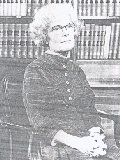
(1903 - 1971)
Kathleen Yardley Lonsdale
(Chemist)
Kathleen Lonsdale was born in 1903 in Newbridge , Co.Kildare, the 10th child of a local postmaster. She came from a poor family, where four of her six brothers died in infancy. In 1908, the family moved to Essex, England. Lonsdale who had inherited a good ability for simple arithmetic from her father attended classes in the boys school in Ilford, where subjects like maths and science were being taught. As a girl, she was alone in these classes.
At the age of 16, Kathleen Lonsdale went to Bedford College, in London to study Physics, which she graduated from, in 1922, coming top in her BSc exams. Having suffered from rickets as a child, she did not grow very tall, but her small size was perfect for the Bedford College rowing eight, whom she coxed for. She also had an interest in music, at college, and was secretary of the Music Society.
On leaving college, Lonsdale was offered a place in the research team of the Nobel prize winners, Lawrence Bragg (1890-1971) and William Bragg (1862-1942). It was then that she began her work on x-ray crystallography. Throughout her life she made fundamental contributions to x-ray crystallography and the study and structure of molecules using x-rays.
In 1929, in Leeds, while studying crystals, she showed that Benzene a vitally important structure in organic chemistry, was a flat regular hexagon. Other crystallographic subjects studied by Lonsdale included the magnetic susceptibility of crystals and the structure of synthetic diamonds.
Structure of Benzene
In 1946 she moved back to London, where she
became Professor of Chemistry and head of the Department of
Crystallography at the
University College
. In 1945, when after 285 years,
the
Royal Society
decided to allow women as members, Kathleen
Lonsdale was the first woman to be elected to fellowship of the
society. In 1968, she became the first woman President
of the
British Association for the Advancement of
Science. In addition, she
edited the first three volumes of the International
tables for x-ray crystallography (1952, 1959, 1962)
.
She was appointed Dame Commander of the Order of the British
Empire in 1956. There was fear that Lonsdale's career having
only begun was to end when she married Thomas Lonsdale and moved
to Leeds. But despite having three children, she continued her
career with her husband's support. In 1935, Lonsdale became a Quaker and a
convinced pacifist. Her strong beliefs led to her serving a
months jail service in Holloway Prison in 1943, when as a form of
protest against World War II, she refused to register for civil
defence duties, and also to pay the £2 fine. When she later
became a prison visitor, she was able to draw on her experience,
to emphatise with other prisoners and request better conditions
on their behalf. Throughout her life, she worked tirelessly for
various causes including peace, penal reform and the social
responsibility of science. She supported the
Pugwash movement
and was President of the
Women's International League for Peace
and Freedom . She
generously gave assistance to collegues and co-workers, and
encouragement to young people to enter the field of science.
This remarkable lady died from cancer on April 1st 1971. 
Awards:
Later life:
![]()
![]()
![]()